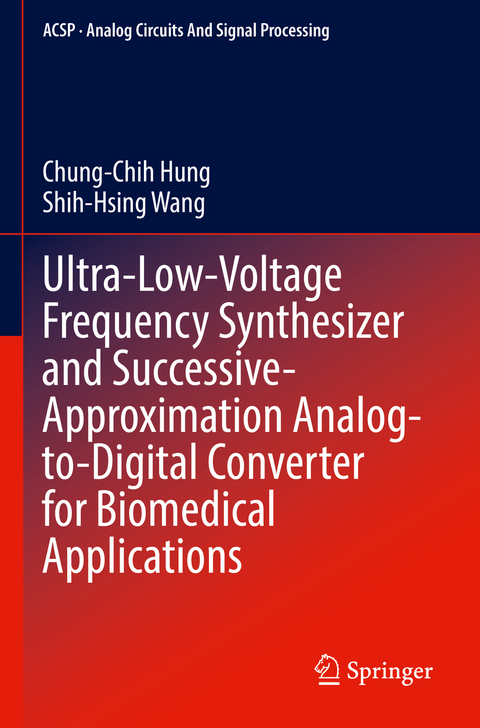
Ultra-Low-Voltage Frequency Synthesizer and Successive-Approximation Analog-to-Digital Converter for Biomedical Applications
Springer International Publishing (Verlag)
978-3-030-88847-3 (ISBN)
This book introduces the origin of biomedical signals and the operating principles behind them and introduces the characteristics of common biomedical signals for subsequent signal measurement and judgment. Since biomedical signals are captured by wearable devices, sensor devices, or implanted devices, these devices are all battery-powered to maintain long working time. We hope to reduce their power consumption to extend service life, especially for implantable devices, because battery replacement can only be done through surgery. Therefore, we must understand how to design low-power integrated circuits.
Both implantable and in-vitro medical signal detectors require two basic components to collect and transmit biomedical signals: an analog-to-digital converter and a frequency synthesizer because these measured biomedical signals are wirelessly transmitted to the relevant receiving unit. The core unit of wireless transmission is the frequency synthesizer, which provides a wide frequency range and stable frequency to demonstrate the quality and performance of the wireless transmitter. Therefore, the basic operating principle and model of the frequency synthesizer are introduced. We also show design examples and measurement results of a low-power low-voltage integer-N frequency synthesizer for biomedical applications. The detection of biomedical signals needs to be converted into digital signals by an analog-to-digital converter to facilitate subsequent signal processing and recognition. Therefore, the operating principle of the analog-to-digital converter is introduced. We also show implementation examples and measurement results of low-power low-voltage analog-to-digital converters for biomedical applications.Chung-Chih Hung received the B.S. degree in electrical engineering from National Taiwan University, Taipei, Taiwan, in 1989, and the M.S. and Ph.D. degrees in electrical engineering from The Ohio State University, Columbus, Ohio in 1993 and 1997, respectively. From 1997 to 2003, he worked for several IC design companies in San Jose, CA and San Diego, CA, where he held analog circuit design manager and director positions and successfully designed many chips in mass production. Since 2003, he has been with National Yang Ming Chiao Tung University, Hsinchu, Taiwan, where he is currently a Professor in the Department of Electrical and Computer Engineering. He is the Deputy Director of the Biomedical Electronics Translational Research Center (BETRC) in National Yang Ming Chiao Tung University. Dr. Hung has served on the Steering Committees of the IEEE MWSCAS and technical program committees of some IEEE conferences. He and his students have won several Best Paper Awards at international conferences. He has been the Deputy Editor-In-Chief of Analog Integrated Circuits and Signal Processing since 2013 and currently serve as Associate Editor of IEEE Transactions on Biomedical Circuits and Systems. Dr. Hung has authored/co-authored over 100 peer-reviewed papers and book chapters and held several US patents. His research interests include the design of analog and mixed-signal integrated circuits for biomedical, power management, and communication applications. Shih-Hsing Wang received the M.S. degree in Electronics Engineering from National Taiwan University of Science and Technology, Taipei, Taiwan, in 1993 and Ph.D. degree in electrical and computer engineering from National Chiao Tung University, Hsinchu, Taiwan in 2020. From 1993 to now, he has been working in several IC design companies in Hsinchu Science Park, Taiwan. He is currently the head of Memory Design and Analysis Division in Etron Technology, Inc. He has published 17 US patents in the DRAM/ADC/PLL related fields. His research interests include high-speed DRAM circuit, mixed-signal ADC/DAC circuit, and PLL/DLL circuit design.
1. Introduction to biomedical signals and their applications.- 2. Low-power and low-voltage VLSI Circuit design Techniques for Biomedical Applications.- 3. Introduction of Frequency Synthesizer.- 4. A 0.35-V 240-miW Fast-Lock and Low-Phase-Noise frequency synthesizer for implantable biomedical applications.- 5. Introduction of ADC.- 6. A 0.3V 10b 3MS/s SAR ADC with comparator calibration and kickback noise reduction for biomedical applications.- 7. Summary.
| Erscheinungsdatum | 10.12.2022 |
|---|---|
| Reihe/Serie | Analog Circuits and Signal Processing |
| Zusatzinfo | X, 222 p. 190 illus., 140 illus. in color. |
| Verlagsort | Cham |
| Sprache | englisch |
| Maße | 155 x 235 mm |
| Gewicht | 359 g |
| Themenwelt | Technik ► Elektrotechnik / Energietechnik |
| Schlagworte | Analog Design Essentials • Analog-to-Digital Converter • CMOS IC Design for Wireless Medical and Health Care • Low Power RF Systems • Ultra-Low-Power Short-Range Radios |
| ISBN-10 | 3-030-88847-9 / 3030888479 |
| ISBN-13 | 978-3-030-88847-3 / 9783030888473 |
| Zustand | Neuware |
| Haben Sie eine Frage zum Produkt? |
aus dem Bereich


